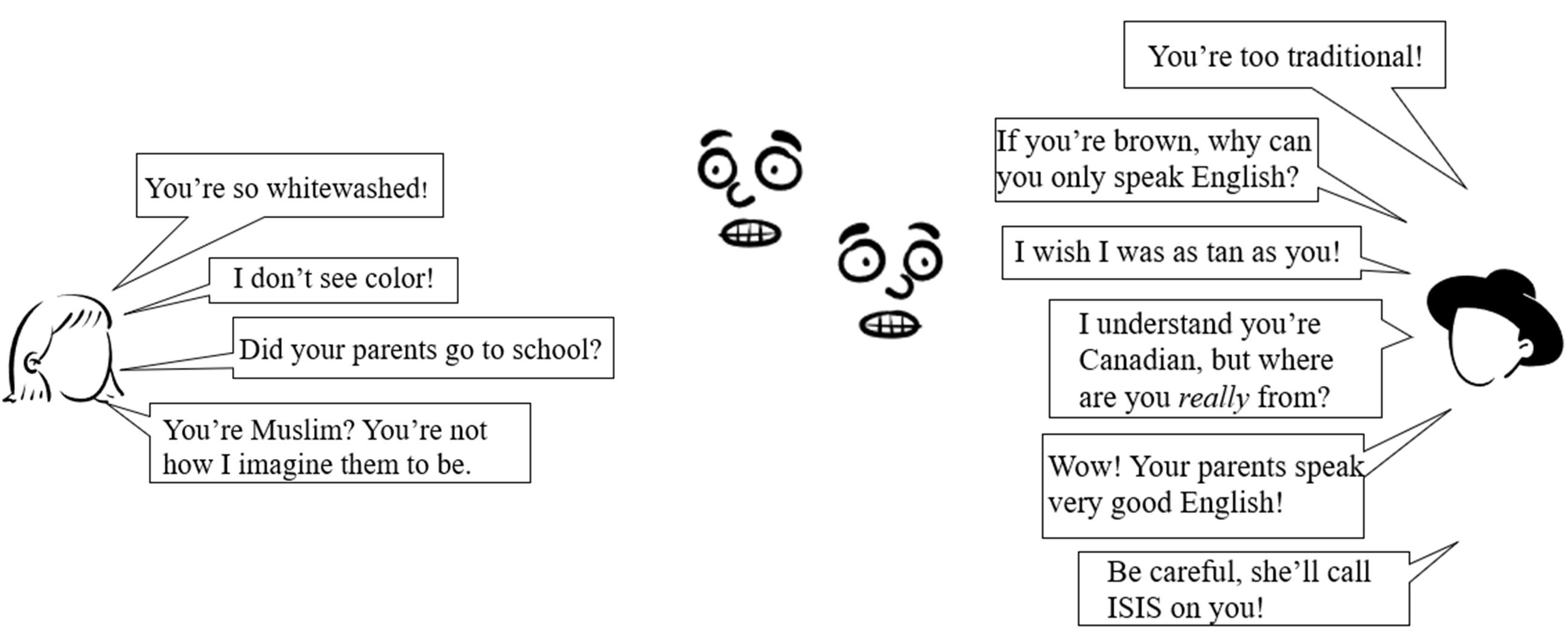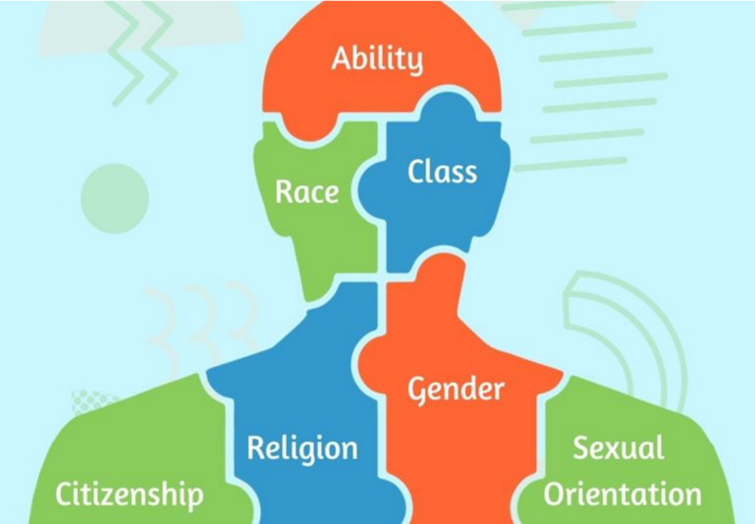Microaggressions & systemic racism: How I washed out like a pair of black jeans

Sara Mohamed
Master of Clinical Science (MClSc), Faculty of Health Sciences | Western University
January 22, 2023
As a person of colour living in Canada, sometimes I feel like a pair of black jeans. Like a pair of jeans do over time, I have gradually faded.
I have gone through way too many black pairs of jeans in my lifetime. Black jeans are a staple in my closet, but they wear out too fast. It’s not that big of a deal because I can buy more black dye to bring the colour back. After a while though, the wear-and-tear of the jeans start to show, and I need to replace them.
I empathize with black jeans. The jeans themselves are not to blame for wearing out so quickly. Instead, there are a variety of factors that can impact the life cycle of jeans. How are they treated? Are they carefully hand-soaked or just thrown in the washer and dryer? How often are they worn? How long have I had them? Are they good quality? Were they made fade-resistant? What environment(s) are they worn in? Are steps being taken to actively try and prevent their washout, such as through spot treatment or using the best detergent? Did the owner of the jeans take time to read the care label to learn how to optimize the jean’s life span?

I can relate to black jeans. Many people probably can in their own way. Like black jeans, I gradually fade as I assimilate into Western culture. However, it is not my colour that is fading, but my unique identity.
Why try to fit in if it’s at the expense of your identity and individuality?
Simply put, it’s safer, it’s easier, and it’s rewarding.
Canada is ethnically diverse (Government of Canada, 2022); however, this does not imply that racism and discrimination do not exist here. This may be explained by insufficient efforts made to decolonize systemic practices and ideologies that were prevalent during colonial times. During this period, anything that differed from the Western European practice or point of view was typically not accepted (Saneda & Field, 2020). However, this is not to say that no progress has been made relating to the acceptance of diversity and openness to pluralism.
Racism and discrimination may not look the same as they did in the past. Just as living organisms or viruses evolve to thrive in their specific environment, so has racism in Canada. Overt racism is not generally tolerated or condoned in our society. To survive, it must be very subtle or almost invisible. Two forms of modern racism that meet this criterion include microaggressions and structural racism. Microaggressions are subtle verbal, behavioural, or environmental insults that communicate bias toward historically marginalized groups (Limbong, 2020). Structural racism is a type of racism that is integrated into the laws, policies, and/or regulations of a society or an organization and manifest as discrimination (Bravemen et al., 2022).
From a young age, I learned that darker skin was undesirable. People would tell me to “Stay out of the sun, or else you’ll tan!” The dangers of sun exposure were about aesthetics rather than health. Ironically, it was usually people from my own culture or other people of colour telling me this. As I grew up, I realized that these comments were coming from experiences they had internalized that led them to adopt a Western standard of beauty, which included having fair skin and light eyes. Sometimes it got confusing though when the slights contradicted or opposed one another. Some examples are shown in the graphic below.

Similar to how jeans are impacted by the way they are treated as well as the frequency and duration they’ve been experiencing wear-and-tear, I am affected by the way people treat me. I was not made fade-resistant, and thus, the more of these microaggressions I heard, the more I chose to wash myself out. Eventually, I mastered the skill of separating myself from anything that would make me the “other”. This would involve avoiding conversations about faith and my culture and being very selective about when to include my last name in contexts where I was being evaluated.
The effect of racism and discrimination goes further than impacting one’s sense of identity and social life. It affects every aspect of life, including health. Structural violence occurs when these effects harm individuals or groups. Let me explain with a story. My great-aunt is an older adult who has numerous health conditions. She was experiencing gastrointestinal issues and was in severe pain, so she decided to go to the hospital. She did not tell anyone and went by herself. She was admitted and eventually called my mom to tell her what was going on at which point my mom immediately left for the hospital to see her. No one had checked in with my great-aunt since being admitted and when my mom questioned this, the reason was that the healthcare professionals did not know that my great-aunt could speak English.
Structural violence is a term coined by Johan Galtung. It is defined as social structures – economic, political, legal, religious, and cultural- that stop individuals, groups, and societies from reaching their full potential (Farmer et al., 2006). These structures appear nearly invisible as they are integrated into established “ubiquitous social structures, normalized by stable institutions and regular experience.” (Farmer et al., 2006) Examples include racism, poverty, disparate access to resources and the experience of my great elderly aunt as her quality of health care was compromised due to an assumption based on her skin colour. Microagressions perpetuate structural violence against individuals belonging to marginalized groups by minimizing and dehumanizing them (Hamilton, 2020).
The environments in which a pair of black jeans are exposed or in which they are worn influence the length it takes for them to fade. The impacts of microaggressions and structural violence likewise depend on context. The country and contexts individuals reside in or belong to, respectively, impact their quality of life, ability to overcome adversity, and the way they experience the world in general (Ungar, 2013). Intersections of one’s identity can lessen or further exacerbate the impacts of structural violence (Swartz, 2019). Identifying with multiple marginalized identities may contribute to numerous negative consequences and can add a layer of complexity when aspects of one’s identity can result in discrimination within a group with which an individual identifies (Singh et al., 2021). An example of negative experiences multiplying as a result of intersectional identities can be seen in the healthcare setting. Gender bias in healthcare can prevent women from receiving the same evidence-based care when presenting with the same condition as male patients, particularly in cardiac care and pain management (Paulsen, 2020). Women of colour also experience inequities related to sexual and reproductive health and rights (Coen-Sanchez et al., 2022). Belonging to multiple vulnerable groups can lead to compound inequities, such as poorer health outcomes among women of colour.
 Intersectionality (ParentsTogether, 2021)
Intersectionality (ParentsTogether, 2021)
Active efforts to prevent black jeans from washing out, such as using an appropriate detergent and learning to care for them by reading the label, are valuable. So, also is taking steps to actively minimize or eradicate racism. This could involve speaking up if you hear racist comments or witness discrimination, and building cultural sensitivity and competence amongst yourself and others.
References:
Braveman, P. A., Arkin, E., Proctor, D., Kauh, T., & Holm, N. (2022). Systemic and structural racism: Definitions, examples, health damages, and approaches to dismantling. Health Affairs, 41(2), 171–178. https://doi.org/10.1377/hlthaff.2021.01394
Coen-Sanchez, K., Idriss-Wheeler, D., Bancroft, X., El-Mowafi, I. M., Yalahow, A., Etowa, J., & Yaya, S. (2022). Reproductive justice in patient care: Tackling systemic racism and health inequities in sexual and reproductive health and rights in Canada. Reproductive Health, 19(1). https://doi.org/10.1186/s12978-022-01328-7
Farmer, P. E., Nizeye, B., Stulac, S., & Keshavjee, S. (2006). Structural violence and clinical medicine. PLoS Medicine, 3(10), 1686-1691. doi:10.1371/journal.pmed.0030449
Government of Canada, D. of J. (2022, August 26). Cultural diversity in Canada: The Social Construction of Racial Difference. 2. Cultural Diversity in Canada. Retrieved January 16, 2023, from https://www.justice.gc.ca/eng/rp-pr/csj-sjc/jsp-sjp/rp02_8-dr02_8/p2.html
Hamilton, B. (2020, July 29). Microaggressions as violence. PracticalMattersJournal. Retrieved January 17, 2023, from http://practicalmattersjournal.org/2020/07/28/microaggressions-as-violence/
Limbong, A. (2020, June 9). Microaggressions are a big deal: How to talk them out and when to walk away. NPR. Retrieved January 16, 2023, from https://www.npr.org/2020/06/08/872371063/microaggressions-are-a-big-deal-how-to-talk-them-out-and-when-to-walk-away
Paulsen, E. (2020). Recognizing, addressing unintended gender bias in patient care. Duke Health Referring Physicians. Retrieved October 28, 2022, from https://physicians.dukehealth.org/articles/recognizing-addressing-unintended-gender-bias-patient-care
Saneda, T., & Field, M. (2020, November 17). Legacy of colonialism. Social Sci LibreTexts. Retrieved January 16, 2023, from https://socialsci.libretexts.org/Bookshelves/Anthropology/Cultural_Anthropology/Book%3A_Cultural_Anthropology_(Saneda)/03%3A_Globalization_Modernization_and_Development/3.03%3A_Legacy_of_Colonialism
Singh, R. S., Bhambhani, Y., Skinta, M. D., & Torres-Harding, S. R. (2021). Measurement of intersectional microaggressions: Conceptual barriers and recommendations. Perspectives on Psychological Science, 16(5), 956–971. https://doi.org/10.1177/1745691621991855
Swartz, C. (2019, July 19). Understanding intersectionality and structural violence. WOW Fellowship Blog. Retrieved January 16, 2023, from http://blogs.brandeis.edu/wowblog/2019/07/15/understanding-intersectionality-and-structural-violence/
Ungar, M. (2013). Resilience, trauma, context, and culture. Trauma, Violence, & Abuse, 14(3), 255–266. https://doi.org/10.1177/1524838013487805
Photo credit:
ParentsTogether. (2021, June 15). Explain intersectionality to kids with this simple metaphor. ParentsTogether. Retrieved October 28, 2022, from https://parents-together.org/explain-intersectionality-to-kids-with-this-simple-metaphor/
Photo by Alex Motoc on Unsplash
